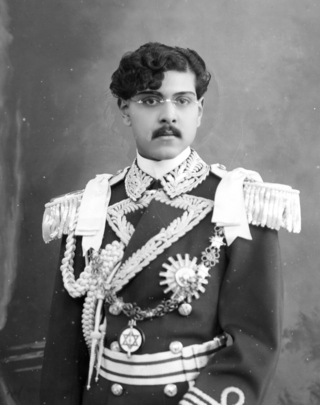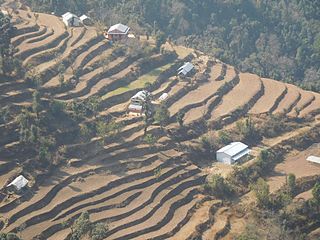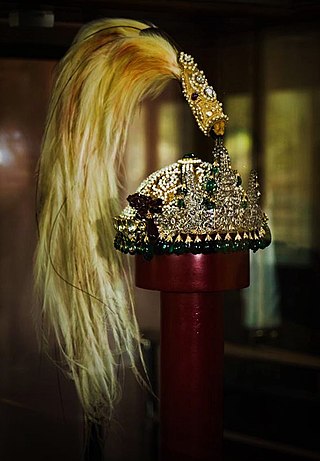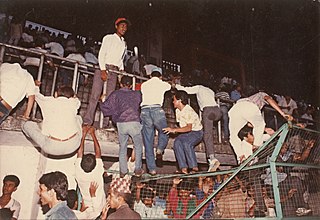
The Kingdom of Nepal was a Hindu kingdom in South Asia, formed in 1768 by the expansion of Gorkha Kingdom, which lasted until 2008 when the kingdom became the Federal Democratic Republic of Nepal. It was also known as the Gorkha Empire, or sometimes Asal Hindustan. Founded by King Prithvi Narayan Shah, a Gorkha monarch who claimed to be of Khas Thakuri origin, it existed for 240 years until the abolition of the Nepalese monarchy in 2008. During this period, Nepal was formally under the rule of the Shah dynasty, which exercised varying degrees of power during the kingdom's existence.

Tribhuvan Bir Bikram Shah was King of Nepal from 11 December 1911 until his death. Born in Kathmandu, the capital city of Nepal, he ascended to the throne at the age of five, upon the death of his father, Prithvi Bir Bikram Shah, and was crowned on 20 February 1913 at the Nasal Chowk, Hanuman Dhoka Palace in Kathmandu, with his mother acting as regent. At the time of his crowning, the position of monarch was largely ceremonial, with the real governing power residing with the Rana family.

Mahendra Bir Bikram Shah Dev was the King of Nepal from 13 March 1955 until his death in 1972, which was due to heart attack as told in an interview by his personal physician Dr. Mrigendra Raj Pandey. Following the 1960 coup d'état, he established the partyless Panchayat system which governed the country for 28 years until the introduction of multiparty democracy in 1990. During his reign, Nepal experienced a period of industrial, political and economic change that opened it to the rest of the world for the first time after the 104-year-long reign of the Rana rulers, who had kept the country under an isolationist policy, came to an end in 1951.

Birendra Bir Bikram Shah Dev was the tenth Shah Ruler and the King of Nepal from 1972 until his assassination in 2001. He was the eldest son of King Mahendra.

Dailekh District a part of Karnali Province, is one of the 77 districts of Nepal. The district, with Dailekh as its district headquarters, covers an area of 1,502 km2 (580 sq mi) and had a population of 225,201 in 2001 and 261,770 in 2011.

Ratna Rajya Lakshmi Devi Shah is a member of the Nepalese Royal Family who was Queen consort of Nepal from 1955 to 1972 and Queen dowager from 1972 to 2008 when the royal family were stripped of all titles and privileges. She is the second wife of King Mahendra (1920–1972). Ratna belongs to the aristocratic Rana family and is the daughter of Field Marshal Hari Shamsher Jang Bahadur Rana and his wife, Megha Kumari Rajya Lakshmi.

New Road is the financial hub and a busy high street in Kathmandu, Nepal Nepal. It refers to a two lane street in the center of Kathmandu, as well as the surrounding neighborhood. It is one of the busiest marketplaces in the city. Being near the midpoint of the ring road in Kathmandu, as well as the old center of Kathmandu, it is one of the central locations in the city.
Kantipur was a medieval kingdom in the Malla confederacy of Nepal. The name of the kingdom was derived from the Sanskrit name of its capital city, now known as Kathmandu.

The Narayanhiti Palace Museum is a public museum in Kathmandu, Nepal located east of the Kaiser Mahal and next to Thamel. The museum was created in 2008 from the complex of the former Narayanhiti Palace following the 2006 revolution. Before the revolution, the palace was the residence and principal workplace of the monarch of the Kingdom of Nepal, and hosted occasions of state.
Ratna Rajya Laxmi Campus, commonly known as RR Campus, is a constituent college of Tribhuvan University (TU). It is also the largest college for the Humanities and Social sciences studies. It provides under-graduate and master's degree level programs. The college was named after Queen Ratna Rajya Lakshmi Devi Shah, second wife of the then King Mahendra Bir Bikram Shah Dev.

Hanuman Dhoka is a complex of structures with the Royal Palace of the Malla kings and also of the Shah dynasty in the Durbar Square of central Kathmandu, Nepal. It is spread over five acres. The Hanuman Dhoka Palace gets its name from the stone image of Hanuman, the Hindu deity, that sits near the main entryway. 'Dhoka' means door or gate in Nepali. The buildings were severely damaged in the 2015 earthquake.

Dharma Ratna Tuladhar, popularly known as Dharma Ratna Yami was a Nepalese government deputy minister, activist and Newa language writer

The coronation of the Nepalese monarch was a rājyābhiṣeka, a Hindu religious ceremony in which the King of Nepal was crowned. The last coronation was held on 4 June 2001 for King Gyanendra. The Kingdom of Nepal was the last Hindu monarchy in the world at the time of its dissolution in 2008.
The Mahendra Museum is a museum located in Nepal. The museum is situated inside Hanuman Dhoka palace Museum in Kathmandu Durbar square. The museum is named in honor of His Majesty Mahendra Bir Bikram Shah Dev.
Princess Sharada Shah of Nepal or Sharada Rajya Lakshmi Devi Shah was the middle daughter of King Mahendra of Nepal. Princess Sharada and her husband, Kumar Khadga, were two of the ten members of the Nepalese royal family killed in the Nepalese royal massacre.
Princess Helen Rajya Lakshmi Devi Shah of Nepal was a member of the former Nepalese royal family. She was the wife of Prince Basundhara of Nepal, a son of King Tribhuvan of Nepal and his second wife, Queen Ishwari.
Mahendra Ratna Multiple Campus is one of the constituent campuses of Tribhuvan University in Ilam district in eastern Nepal. The campus was established in Asar 21, 2017 BS. The campus is also approved by University Grants Commission of Nepal. The campus was named after the then-ruling monarch King Mahendra and his wife Queen Ratna.

Ratna Mandir is a former palace used by the Nepalese royal family.


















